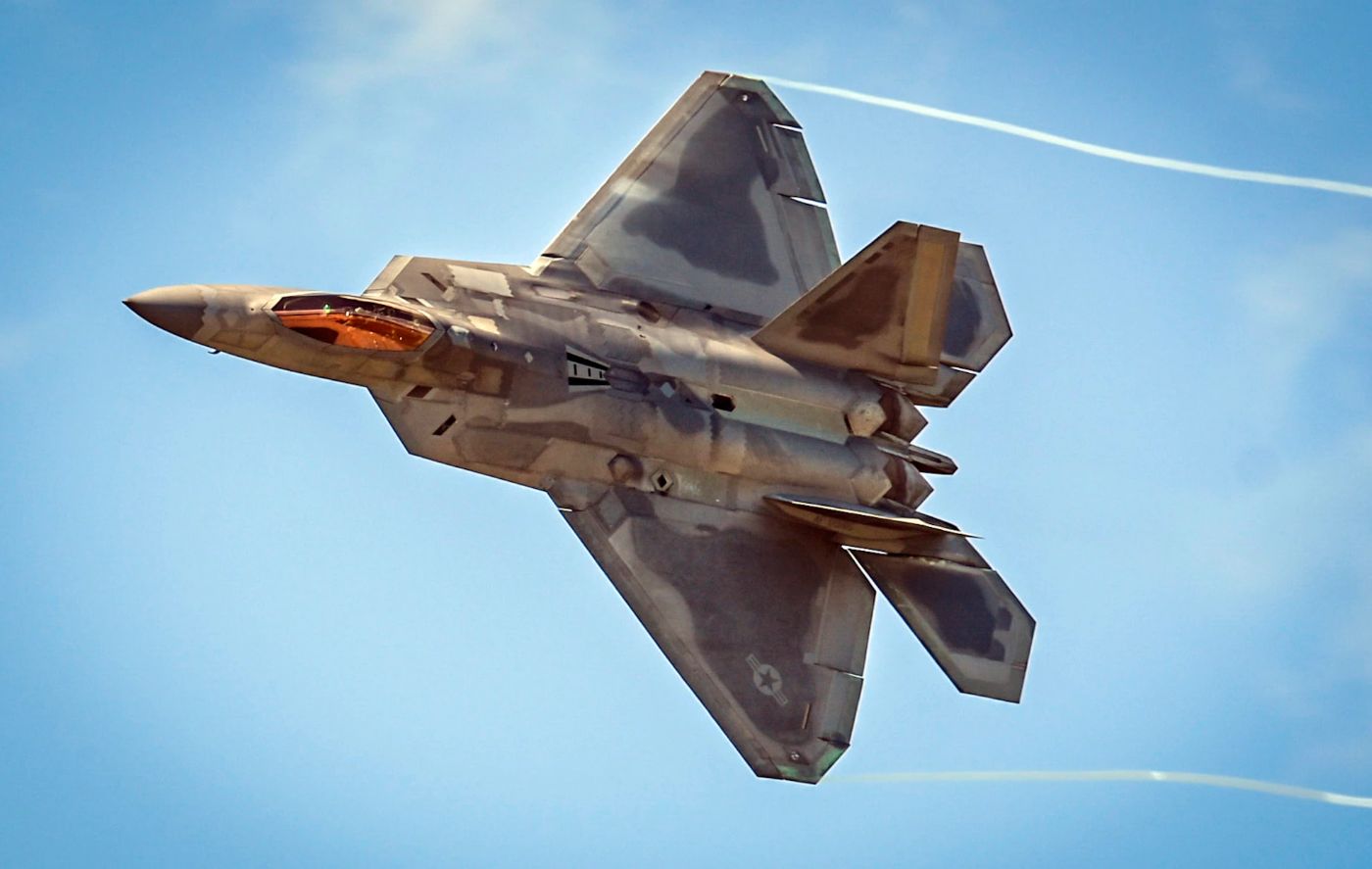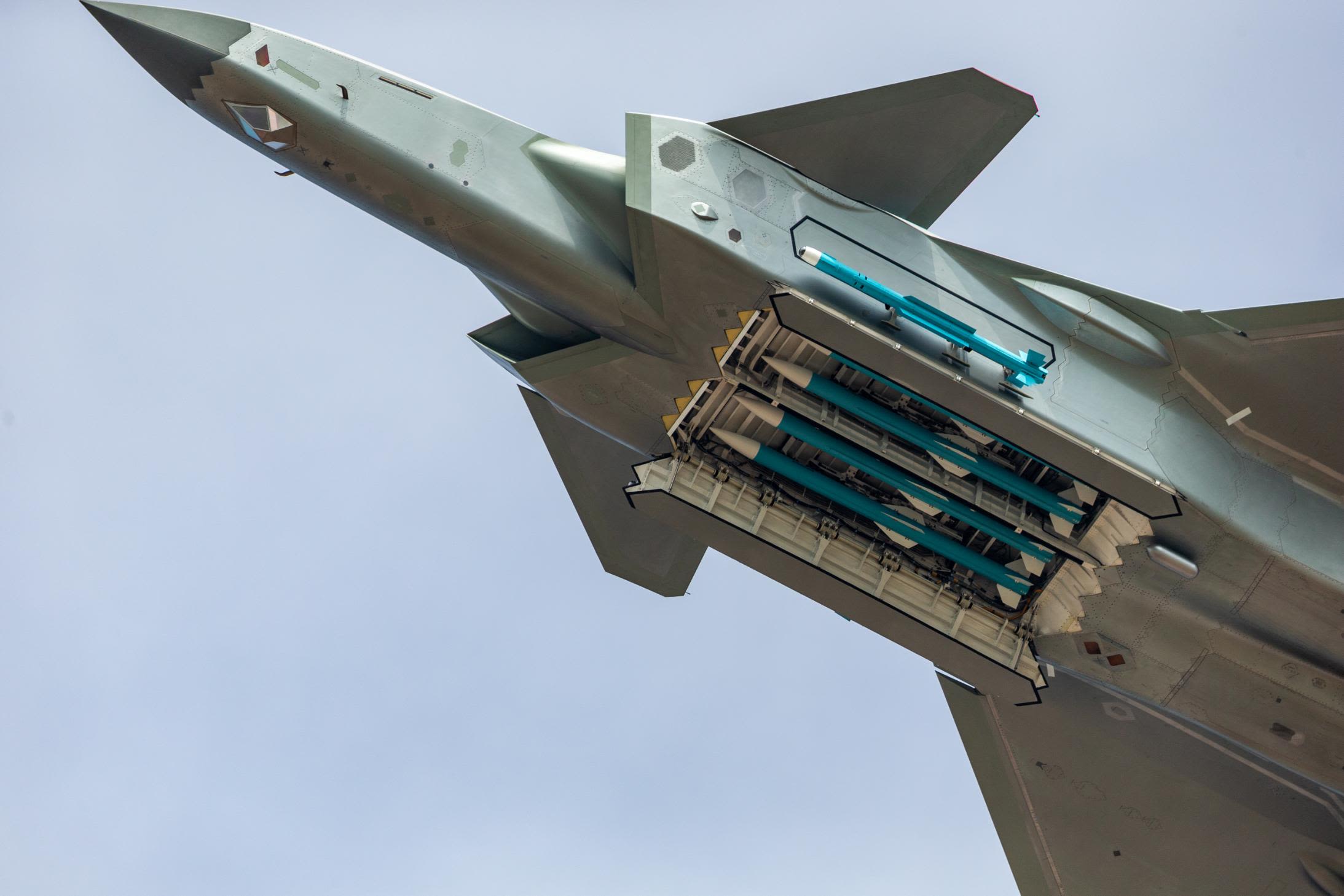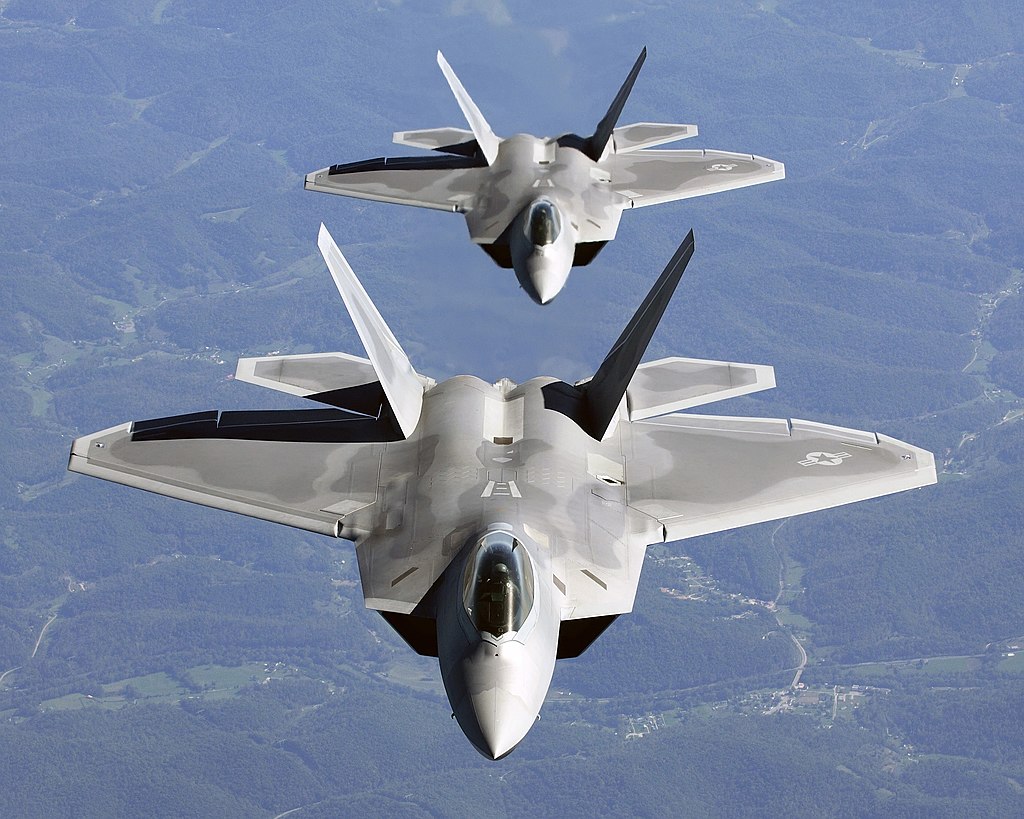As the great power competition between the U.S. and China shifts from competition towards confrontation, the U.S. Air Force (USAF) has begun moving its F-22 Raptors to airbases not too far from the Chinese mainland.
The USAF deployed F-22 Raptors based at 1st Fighter Wing Langley, Virginia, to Kadena Air Base in Japan. Kadena is on Okinawa Island, just 650 kilometers from mainland China and a similar distance to Taipei, Taiwan. The F-22 is mostly stationed in the U.S. Mainland.
Kadena Air Base
The Kadena Air Base was built by the Japanese in 1945. After the war, it was taken over by the U.S. forces. On 1 November 1954, the 18th Fighter-Bomber Wing arrived from Osan Air Base, South Korea, and has been there ever since.
At the end of the Eisenhower presidency, in January 1961, around 1,700 nuclear weapons were deployed onshore in the Pacific, 800 of which were at Kadena Air Base. The base had seen huge operational action during the Korean and Vietnam wars. Post-Vietnam, it was meant to assist Taiwan’s air defense against threats from China.
The airbase has two 12,000-foot-long runways and is often referred to as the “Keystone of the Pacific” because of its highly strategic location. It is just 770 km from Shanghai, China’s major economic hub.
The Wing has long had two F-15C/D Eagle Squadrons, a KC-135R/T Stratotanker unit, an E-3B/C Sentry unit, and an HH-60 Pave Hawks Rescue Squadron. It also operates the MC-130J Commando II and the CV-22B Osprey for Special Operations. The Patriot PAC-III AD unit has been there to defend the base against tactical ballistic missiles from North Korea. For a long time, the SR-71 aircraft operated from here.
In 2023, the Air Force began withdrawing the two F-15C/D squadrons and temporarily replacing them with fighters from elsewhere, including F-16s, F-35s, and now F-22s. In late 2023, there were also reports that USAF would permanently station Boeing F-15EX Eagle II jets at Kadena.
Over 20,000 American service & family members, as well as Japanese employees, live or work at Kadena Airbase. It is the largest and most active U.S. Air Force base in East Asia. Every month, 650 aircraft arrive and depart, moving more than 12,000 passengers and nearly 3,000 tons of cargo.
The deployment of the F-22 to Kadena in late April 2024 was called a routine rotation of fighter jets. The squadron has around 20 stealthy fighters. For the first time, the F-22 could face its PLA Air Force (PLAAF) counterparts, the J-20 “Mighty Dragon” fifth-generation fighter across the sea.
In the event of war, the PLA can be expected to attack U.S. bases in the Western Pacific region, including Kadena, which is within short-range ballistic missile and cruise missile attack range.
F-22 Raptor
The Lockheed Martin F-22 Raptor is an American twin-engine stealth fifth-generation fighter aircraft. It was a product of the USAF’s Advanced Tactical Fighter (ATF) program and was designed as an air superiority fighter. However, it also incorporates ground attack, electronic warfare, and signals intelligence capabilities.
The F-22’s shape combines stealth and aerodynamic performance. Plan form and panel edges are aligned, and surfaces have continuous curvature to minimize their radar cross-section (RCS).

It made its first flight in September 1997, 27 years ago, and was inducted into the USAF in December 2005. Although the USAF had originally planned to buy 750 ATFs and later scaled down to 381, the program was cut to 195 aircraft due to high costs and the development of the more affordable and versatile F-35.
At last count, the cost of the F-22 aircraft was $227 million. In 2015, the cost per flight hour was $68,000 per hour, nearly three times that of the F-16 and 1.5 times that of the F-15.
When the F-22 numbers were fixed, the Chinese fighter developments were accounted for. Also, it was decided to extend the life of F-15C/Ds and replace them with new-build F-15EX. The Long Range Strike Bomber program was also moving ahead. Fresh production stopped in 2011.
The aircraft was originally meant to replace the F-15 Eagle. While designed for counter-air operations, the aircraft has also performed strike and electronic support missions in the Middle East against the Islamic State.
The F-22 will remain a cornerstone of the USAF’s fighter fleet until it is succeeded by the crewed Next Generation Air Dominance (NGAD) fighter. To prevent the inadvertent disclosure of the aircraft’s stealth technology and classified capabilities to the U.S.’s adversaries, it was decided to prohibit or license the sale of the F-22 to any foreign government. Countries like Japan, Australia, and Israel had shown serious interest in purchasing the aircraft.
F-22 was the first operational aircraft to combine super-cruise, super-maneuverability, stealth, and integrated avionics (or sensor fusion) in a single weapons platform. The aircraft’s dual Pratt & Whitney F119 augmented turbofan engines (156 kN thrust) are closely spaced and incorporate pitch-axis thrust vectoring nozzles that are fully integrated into the F-22’s flight controls and vehicle management system.
Unlike the F-117 and J-20, the F-22 is less reliant on RAM, which is maintenance-intensive and susceptible to adverse weather conditions. Of course, low-frequency radars, such as weather radars and early-warning radars, can detect stealth aircraft.
Beginning in 2021, the F-22 has been seen testing a new chrome-like surface coating. The new coating will help to reduce the F-22’s detectability by IRST and other infrared tracking systems and missiles.
The aircraft’s integrated on-board avionics and off-board inputs fusion increase crew situational awareness and reduce workload. The AESA APG-77 radar has a low-observable, active-aperture, tilted antenna for stealth. Its emissions can be focused on overloading enemy sensors as an electronic-attack capability. The F-22 can perform “mini-AWACS” functions by data transfers to other surface/airborne platforms.
Like all stealth aircraft, the F-22 has internal weapons bays. A large main bay is on the bottom of the fuselage, and two smaller bays are on the sides of the fuselage. It can accommodate six AIM-120 AMRAAM BVR missiles in the main bay or even the AIM-260 JATM and one missile each in smaller bays. There are four external hard points for fuel tanks for long-range missions.
The aircraft was envisaged to spearhead offensive and defensive counter-air operations (OCA/DCA) in a highly contested environment against Russia or China.
The F-22 has also been used to test technology for its eventual successor from the Next Generation Air Dominance (NGAD) program, and some advances are to be applied to it as well. Aside from capability upgrades, the F-22’s structural design and construction were improved in 2021.
The F-22 was first deployed overseas in February 2007 with the 27th Fighter Squadron to Kadena Air Base in Okinawa, Japan. They have also been involved in training exercises in South Korea and Malaysia.
They made their first deployment in West Asia in 2009 at Al Dhafra Air Base in the UAE, around 360 kilometers from Iran. On 22 September 2014, F-22s performed their first combat sorties by conducting some of the opening strikes of Operation Inherent Resolve, the American-led intervention in Syria, dropping bombs on Islamic State targets.
F-22s flew a total of 204 sorties. The F-22 also performed missions in Afghanistan. On 4 February 2023, an F-22 shot down a Chinese spy balloon within visual range off the coast of South Carolina at an altitude of 60,000 to 65,000 feet, marking the F-22’s first air-to-air kill.
J-20 “Mighty Dragon”
The Chengdu J-20 “Mighty Dragon” is a Chinese twinjet stealth fifth-generation fighter aircraft. It is designed as an air superiority fighter with precision strike capability.
The aircraft has three variants: the initial production model J-20A, the thrust-vectoring J-20B, and the twin-seat aircraft teaming capable J-20S. The aircraft made its first flight in January 2011, and the first J-20 combat unit was formed in February 2018. This made China the second country in the world and the first in Asia to field an operational stealth aircraft. Nearly 240 have been built as of date.

The J-20 has a long and blended fuselage with a chiseled nose section and a frameless canopy. There are low-observable diverterless supersonic inlet (DSI) intakes. It has all-moving canard surfaces with pronounced dihedral. The aft section has twin outward canted all-moving fins, short but deep ventral strakes, and conventional or low-observable engine exhausts.
The aircraft is currently powered by a Chinese WS-10C engine with a thrust of 142-147 kN and serrated afterburner nozzles for enhanced rear-aspect stealth. The final intended powerplant is the Shenyang WS-15 with a thrust of 180 kN, which is crucial for super-cruise and enhanced maneuverability.
The J-20 has yet to leave Chinese soil, even for an air show. It has never been exercised with any foreign air force. J-20s have been seen at Hotan, close to the India-China Line of Actual Control.
J-20s at Wuyishan Airbase
The Wuyishan Airbase in Fujian province is 500 kilometers from Taipei and 980 kilometers from Kadena. The PLAAF 41st Aviation Brigade with J-20 has been at Wuyishan since late 2023.
Open-source satellite imagery of 29 November 2023 shows six J-20s parked in the open at Wuyishan. More aircraft would have followed. As of date, nearly 160-200 J-20s are in operational units, with at least 64-80 or 40% of those airframes stationed in the Eastern Theatre Command (ETC).
This does not include J-20s operated by aggressor units or testing units. The Chinese target is to have 400 aircraft by 2027. Soon, all the Chinese Theatre Commands will have J-20s. Wuyishan Airbase, of course, has many J-11s. The ETC has special significance because of Taiwan and the backing of the USA’s allies and partners.
Fifth-Gen Numbers & Dominance USA Vs PLAAF
The U.S. has a clear advantage in the number of fifth-generation aircraft. The PLAAF appears to be capable of introducing between 48-60 J-20s per year, which at the higher end is greater than the proposed 51 F-35A airframes the United States Air Force (USAF) is budgeting to procure in fiscal year 2024.
At the assumed rate of one flight group worth of aircraft being introduced in the PLAAF every four months and the assumed ability to have at a minimum two aviation brigades converting simultaneously, it would take the PLAAF nearly five years to catch up to even the current total April 2024 inventory of 630 fifth-generation aircraft operated by the USAF.
The United States is the primary customer and financial backer, with planned procurement of 1,763 F-35As for the USAF, 353 F-35Bs, and 67 F-35Cs for the USMC, and 273 F-35Cs for the USN. These are being produced at 80-100 aircraft a year. It will take China years to catch up with the fifth-generation numbers of the U.S. alone. The gap will be huge among the other partners.
The international airspace over the Sea between Kadena and Wuyishan could soon see engagements between the J-20 and the matchless superiority of the F-22, displaying the capabilities of the men and machines.
The J-20 does not have the dominance capabilities of the F-22 and F-35 combined. In any case, China’s initial requirement is to dominate the East and South China Seas, which the J-20 will be well placed to manage when combined with long-range air-to-air missiles (AAM). China still doesn’t have a carrier-based fifth-generation fighter.
F-22 and J-20 Comparison
| F-22 | J-20 | |
| Country | USA | China |
| Length | 18.92 m | 21.2 m |
| Wing Span | 13.56 m | 13.01 m |
| Empty weight | 19,700 kg | 17,000 kg |
| Max Take-Off Weight | 38,000 kg | 37,000 kg |
| Top Speed | Mach 2.25 | Mach 2.0 |
| Internal Bays and Payload | 3 – 6xAIM 120 & 2 AIM-9L | 3 – 4xPL-15 & 2xPL-10 |
| Range Internal Fuel | 3,000 km | 5,500 km |
| Engine and Thrust | 2 × P&W F119-PW-100 (156 kN) | 2 × Shenyang WS-10C (147 kN) |
| Radar and Range | AN/APG-77(V)1 AESA, 400 km | Type 1475 (KLJ-5) AESA, 300 Km |
| AAM (Range) | AIM-260 JATM, 200+ Km | PL-15, 200-300 Km |
J-20 Vs F-22
Americans claim the F-22’s greater asset is its stealth quality, an RCS (radar cross section) the size of a marble. The aircraft’s advanced avionics and weapons systems allow it to engage with targets far beyond visual range.
Its high thrust-to-weight ratio and thrust vectoring make it highly agile. The J-20 Chengdu uses radar-absorbent materials, internal weapon bays, and serrated engine nozzles to minimize radar visibility. But despite all this, the J-20 is still on a learning curve.
Because of its size, China often prefers to compare the J-20 with the larger F-22 rather than the F-35. The F-22 is reportedly superior in dogfighting capabilities, with more missiles, maneuverability, and an internal cannon. The J-20 does not have a cannon.
Currently, the J-20 has the edge over the F-22 in terms of range. Each WS-15 engine of the J-20 produces greater thrust than the PW F119s on the Raptor. However, the reliability of Chinese engines still needs to stabilise. Clearly, the Chinese are way behind in stealth technology and advanced avionics.
The J-20 double-nose canards impact stealth capability. The F-22 has no such surfaces, and it is currently undergoing a major stealth upgrade. Also, the J-20 engine nozzles are still a work in progress for proper serrations.
Though the J-20’s supersonic air inlets, nose radar dome, and electro-conductive cockpit canopy are well designed for signature reduction, it requires the missiles to be locked on the station before firing. This would mean considerable time spent opening the weapon bay door and thus reduced stealth.

Conclusion
As per USAF, the deployment of F-22s aims to enhance dissimilar training and test agile combat employment (ACE) capabilities within the Indo-Pacific region. Raptors at Kadena is likely a strategic response to the growing presence of J-20s across the sea.
The Wuyishan-Kadena face-off between China and the USA is like Sargodha and Ambala between Pakistan and India. Plans to deploy F-22 Raptors to Kunsan AB in South Korea as “Follow-on Forces” to meet overall theatre requirements will also enhance training and increase interoperability.
Overall, the USAF and its allies have a much larger number of fifth-generation fighters in the region than PLAAF.
The F-22 Raptor, often hailed as the pinnacle of air superiority, has had close-combat training with Eurofighter Typhoons and Rafale fighters over the years, and these 4.5 generation aircraft could perform better in many cases.
If such an opportunity came, the same would likely be true for J-20 and Rafale deployed across the Himalayas by the Indian Air Force. Overall, the F-22s have had much higher mission success rates due to late detection. Their main strengths are stealth and sensor fusion.
While F-22s and F-35s are likely to excel against the Might Dragons, India needs to push the development of its fifth-generation Advanced Medium Combat Aircraft (AMCA) fighter for better penetration and to neutralize the J-20.
- Air Marshal Anil Chopra (Retired) is an Indian Air Force veteran fighter test pilot and is the former Director-General of the Center for Air Power Studies in New Delhi. He has been decorated with gallantry and distinguished service medals while serving in the IAF for 40 years. He tweets @Chopsyturvey
- Follow EurAsian Times on Google News




